12 Essential Garden Tools no Gardener Should be Without!
If you are in the garden like I am every day there comes
a time when
you know which essential garden tools you need and which you don't.
Fads come and go, and that can be said too of the gardening world. You will find some new gadget that pops up and gets advertised to death only to find that it really doesn't work as well as those trusty old garden tools that you have, that have stood the test of time.
But before you go out and buy these essential tools, if you are a beginner gardener, you really need to know what to look for, because there is a huge difference in quality and workmanship that goes into making them.
When you buy gardening tools, you really do get what you pay for. Buy quality and you will have them for several decades. Buy cheap garden tools and you will be replacing them several times over. So it pays to make a sound investment from the beginning. But what should you be looking for in these tools, and how do you know that you are buying the best?
So what do you look for in handles for garden tools? Well, the best tools have handles that are comfortable to hold, especially if you are holding it in a firm grip. A handle that has been forged as part of the shaft of the tool is better than one that has been added separately.
If you have a handle and shaft that are separate, check to see that all the screws are present and it is firmly secured.
Finally, to check to see if the spade or fork is the right size for you, place it on the ground. The top of the handle should come up to your elbow.
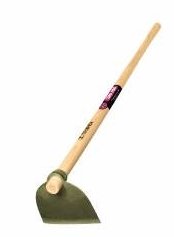 This
is definitely at the top of the list of essential garden tools. I
use my little hoe for so many things. I use it to dig small holes to
plant seedlings, I use it to take out weeds from the garden. I also use
it to break up
the soil before getting the fork in to dig down deeper.
This
is definitely at the top of the list of essential garden tools. I
use my little hoe for so many things. I use it to dig small holes to
plant seedlings, I use it to take out weeds from the garden. I also use
it to break up
the soil before getting the fork in to dig down deeper.
My one regret about the hoe that I bought is that it was made in two parts; the metal blade, and the wooden handle. Occasionally, I have to jump up and down onto the blade to stop it from sliding back and forth along the pole as I use it. Don't make the same mistakes as I did. Buy a hoe that is either all in one, or one that has some form of pinning the blade to the shaft.
The classic garden hoe has a broad, straight, 6-inch steel blade that’s good for all types of gardening, including digging, weeding, chopping, hilling, and cultivating. Longer, and narrower-bladed versions, such as the collinear hoe, are good for weeding in tight spots.
The garden hoe is one piece of
gardening equipment that you want with a wooden handle. That
is because in hot weather, when hands can sweat, you want to be sure
that you will have a firm grip on it at all times.
is one piece of
gardening equipment that you want with a wooden handle. That
is because in hot weather, when hands can sweat, you want to be sure
that you will have a firm grip on it at all times.
 No
matter what the size, garden forks are useful for getting right down
into the soil, with the larger digging fork to a depth of at least 10
inches, and can be used not only to turn the sods over before you
plant, but also can be used to turn your compost piles over and to lift
out those potatoes easily without putting a blade through them if you
were using a spade.
No
matter what the size, garden forks are useful for getting right down
into the soil, with the larger digging fork to a depth of at least 10
inches, and can be used not only to turn the sods over before you
plant, but also can be used to turn your compost piles over and to lift
out those potatoes easily without putting a blade through them if you
were using a spade.
I also use a fork to separate large plants that I want to divide during the year, such as dahlias or agapanthus. This does a far better job than a spade.
Buy a fork that has the head forged from a single piece of steel and have square tines with diamond points for strength and good penetration of the soil. Tines that are V-shaped are also good.
What you don't want is a cheap garden fork where the central tines have been welded on as an after thought. These will break over time. You find with these types of garden forks, that the metal is just clamped into place over the shaft. Again this is a weakness that will cause you problems later on.
Finally, buy an ergonomically designed garden fork. This steel D-handle ergo garden fork has a
lifetime guarantee.
has a
lifetime guarantee.
But a spade is useful. It is great to get those straight edges on garden beds, good for chopping back grass, for cutting open bags of potting soil, and for loading compost into your soil, followed by forking it through.
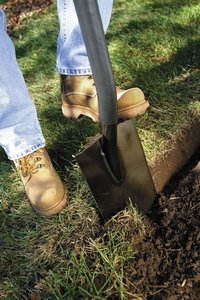 Again,
you want to choose a spade with all the same qualities as the
garden forks. Handles, again should have a comfortable grip, whether
they are metal or wood. You can also get traditional spades made with a
Y-D handle that has been made by splitting the wood of the shaft into 2
and steam-moulding it. These are quite beautiful, and very elegant
looking spades.
Again,
you want to choose a spade with all the same qualities as the
garden forks. Handles, again should have a comfortable grip, whether
they are metal or wood. You can also get traditional spades made with a
Y-D handle that has been made by splitting the wood of the shaft into 2
and steam-moulding it. These are quite beautiful, and very elegant
looking spades.
Choose a spade or a shovel that has a single piece of metal attached to a wooden handle with either a single socket or a single socket that runs 1 foot up the handle (referred to as a solid-strap connection). These models are heavier, but they’re much more durable.
You want a spade that has a cutting edge so that it will be able to get through the sod or roots easily. The treads on top of the spade should be wide enough so that you can place your foot on the spade and work it downwards. A blade collar should encase the shaft and be firmly attached.
Make sure that the spade head is directly in line with the handle, because the spade is meant to be driven straight into the ground. Once in the ground, you need the handle and the shaft to be strong enough to withstand the force of the handle being pulled towards you and levering the spade back and forth whilst in the ground.
Spades are often seen in 2 blade sizes: the digging spade is about 29x30 cm and the smaller cottage spade has a blade of 23x15 cm. The cottage spade is often used for creating good edges for flower beds, but a digging, or garden spade will do the same job just as well.
Also when buying your spade make sure that it has blades that are made of quality alloy steel or stainless steel if you don't want them to rust years down the track. Steel D-handle Square Garden Spade
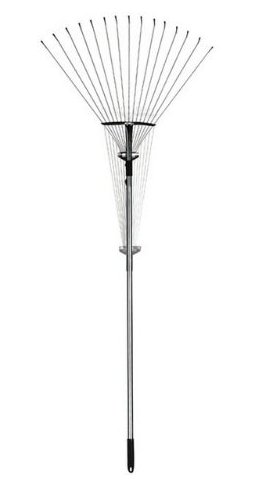 i)
A garden or landscape
rake used for leveling soil when creating new
vegetable gardens or flower beds.
i)
A garden or landscape
rake used for leveling soil when creating new
vegetable gardens or flower beds.
ii) A leaf rake or lawn rake used for gathering up that fall bonus of leaves for composting and making leaf mold, or lawn clippings.
The leaf rake more often than not has a plastic head that should have long tines that spring back a the touch. You can find a leaf rake with metal tines, but these you should be able to adjust the tension of, which is handy if you are working with different materials or surfaces.
The landscape rake is more robust because it allows you to push and pull material around without bending the tines. Usually a garden rake has metal tines, but if it doesn't the plastic tines will be very rigid and durable.
A 14-inch-diameter, iron-toothed rake should have a long, wooden handle that’s securely attached to a metal head. You can flip the metal head over to really smooth a seedbed flat. For a lightweight but less durable version of an iron rake, try an aluminum rake.
Again check that the handles are good, that the shaft is good, and that there are no splinters along the handle if it is a wooden handle. If you are particularly tall person you may find that standard 4 ft (120cm) handle too short. Buy a 6 ft (180cm) spare handle and then replace it when you get home. The shorter handle can be used for a house broom.
An adjustable steel leaf rake is one of the
best you can buy.
is one of the
best you can buy.
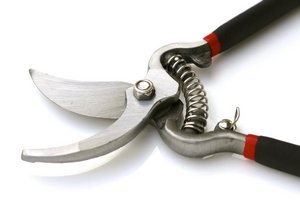 Secateurs or pruning shears
can be used for pruning of all garden shrubs, roses, fruit
trees, etc. And gardeners are rather partial to their secateurs, so
don't ask to borrow them, because the answer will be given unwillingly!
Secateurs or pruning shears
can be used for pruning of all garden shrubs, roses, fruit
trees, etc. And gardeners are rather partial to their secateurs, so
don't ask to borrow them, because the answer will be given unwillingly!
Pruning, however, is very repetitive, and therefore when you do invest in some secateurs make sure that the grip is totally comfortable otherwise you will end up with wrist and arm strain.
Look for handles that grip firmly in the hand, won't slip out when wet and opens and closes easily A good spring that closes the blades quickly and can be replaced when they finally give in.
Make sure that you have quality blades that are sharp for a long time and when they become blunt can be easily sharpened. Therefore look for removable blades to be able to do this.
The locking mechanism should be easy to operate. You want to be able to open and lock the pruning shears with one hand.
with one hand.
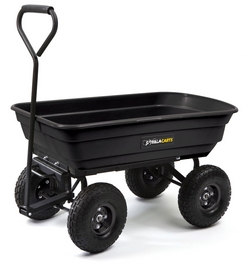 When I was young and foolish
and thought that I could save myself some
money I bought a canvass wheelbarrow. In addition to the fact that it
was cheap, it was also light in weight, and I thought that it would be
the prefect addition to
my collection of essential garden tools. It wasn't. Instead it became a
pain in the neck.
When I was young and foolish
and thought that I could save myself some
money I bought a canvass wheelbarrow. In addition to the fact that it
was cheap, it was also light in weight, and I thought that it would be
the prefect addition to
my collection of essential garden tools. It wasn't. Instead it became a
pain in the neck.
Every time I filled it up, either with cuttings or compost and wanted to tip it out in another location, the damn thing used to fold in on itself quicker than a clam shell. In the end, I went out and bought myself a real wheelbarrow.
You will find plastic wheelbarrows. Stay away from those too. Over time the sun will get to them and the plastic will become brittle and eventually crack.
The only wheelbarrow or garden cart you should be
looking at is a metal one. Yes, it
will
rust over time, but it will take a heck of a long time to do so, as
opposed to all the rest. Pick it up in the shop making sure that it is
well balanced and that the handles feel comfortable.
you should be
looking at is a metal one. Yes, it
will
rust over time, but it will take a heck of a long time to do so, as
opposed to all the rest. Pick it up in the shop making sure that it is
well balanced and that the handles feel comfortable.
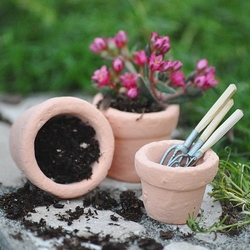 A hand trowel can be used for digging around
plants without worrying
about disturbing the roots, transplanting seedlings, planting out
window boxes and hanging baskets, repotting pot plants,
rooting out weeds, or even spreading small amounts of fertilizer around
your roses.
A hand trowel can be used for digging around
plants without worrying
about disturbing the roots, transplanting seedlings, planting out
window boxes and hanging baskets, repotting pot plants,
rooting out weeds, or even spreading small amounts of fertilizer around
your roses.
The wider-bladed hand trowels, which are scoop shaped and rounded on the end, are easier to use to loosen soil than the narrower-bladed, V-pointed ones.
These narrower blades are better for digging tough weeds, such as dandelions.
A small hand fork can be used for cultivating pot plants or a small garden area, loosening the soil and getting rid of weeds.
Make sure that your mini-garden tools have comfortable grips that feel easy to use, and the tools feel well balanced when you hold them.
The blades are of good quality, if you go for a Stainless Steel Garden Tool Set you will
have these for life.
you will
have these for life.
You want a strong shaft with no screws sticking out which could injure you when using them. and find the tools with the long or extendable handles that will reduce the need for bending and will save your back!
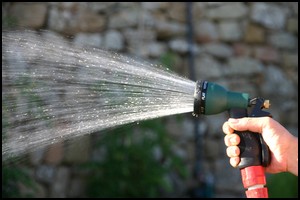 Of you want to get really fancy you can get
soaker hoses, or set up an
irrigation system, but a plain old hose pipe works just as well.
Of you want to get really fancy you can get
soaker hoses, or set up an
irrigation system, but a plain old hose pipe works just as well.
Your idea garden hose is a rubber one that won't kink and cut off the water supply as will happen with the vinyl hoses. When I first moved on to our current farm, I inherited a vinyl hose. With one outside tap servicing both the vegetable garden on one side of the house at the time, and the flower gardens on the other side, watering every day in the summer became a nightmare.
Every time I watered the garden the hoses kinked leaving me standing like an idiot with a hose in one hand and no water coming out the other end. It was also heavy to drag around from one location to the other, often snagging on roots and rocks, and as a result lots of swearing could be heard across the valley on a hot summers day. Believe me, you do not want a vinyl garden hose!
Whatever material you choose, be sure to get a hose that’s long enough to reach all areas of your garden without having to spray water across the flower beds to water plants at the back of beds, or dragging the hose through the beds where you will end up damaging the plants, especially if they are seedlings. Have it fitted with a trigger spray for adjustable water output.
So, what to look out for when buying a garden hose?
Buy a rubber garden hose that is long
enough to reach your flower beds and
veggie gardens. Also, buy one that has brass fittings and a
washer built into the hose.
This will make the hose pipe less likely to fail after prolonged use.
that is long
enough to reach your flower beds and
veggie gardens. Also, buy one that has brass fittings and a
washer built into the hose.
This will make the hose pipe less likely to fail after prolonged use.
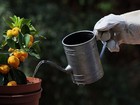 Watering cans can be made of simple, inexpensive,
brightly colored
plastic or high-end, fancy galvanized metal. Plastic is lighter, but
galvanized metal is rustproof and more attractive.
Watering cans can be made of simple, inexpensive,
brightly colored
plastic or high-end, fancy galvanized metal. Plastic is lighter, but
galvanized metal is rustproof and more attractive.
Watering cans also come in different sizes, as you can see from the picture, so try a few out for comfort before buying. And buy the right watering can for the right purpose.
You should be able to easily remove the sprinkler head, or rose, for cleaning. However, the rose should be screwed on, rather than clipped on, as the water often escapes through the unsealed areas.
For watering tender seedlings, buy a can with an oval rose that points upward and applies water with less pressure. The traditional round rose is better for watering more mature plants. I prefer a galvanized watering can .
.
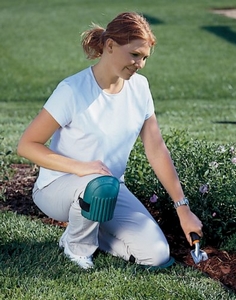 When
you get to my age, comfort is everything! Now I have to confess,
that when I am kneeling on the ground, I have a hard time getting up!
It is not because I am that old, or
overweight, I am just not as supple as I used to be!
When
you get to my age, comfort is everything! Now I have to confess,
that when I am kneeling on the ground, I have a hard time getting up!
It is not because I am that old, or
overweight, I am just not as supple as I used to be!
As a result I love my little canvass stool. I can sit on it and weed, moving it from place to place as I use my little trowel. Not only that, but it has pockets for my seeds, my mini gardening tools, a bottle of water, etc.
The folding garden stool and organizer was given to
me as a gift by my
neighbor and it has been one of the most useful little gifts
I have ever received.
was given to
me as a gift by my
neighbor and it has been one of the most useful little gifts
I have ever received.
Some of you however, are happy with knee pads , because you
do not make
an inelegant sprawl into the rose garden when you get off your knees.
They are loved by many gardeners, especially if
you have stony soil like I do!
, because you
do not make
an inelegant sprawl into the rose garden when you get off your knees.
They are loved by many gardeners, especially if
you have stony soil like I do!
 is the
perfect container.
is the
perfect container.
For a more durable but smaller bucket, buy one made from galvanized steel.
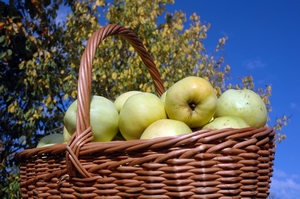 Our last essential garden tool on the list is the
humble basket, hod or
trug.
Wicker baskets, hods and wooden trugs are useful for transporting
flowers from your flower beds,
fruit from your orchards, or vegetables from your veggie gardens.
Our last essential garden tool on the list is the
humble basket, hod or
trug.
Wicker baskets, hods and wooden trugs are useful for transporting
flowers from your flower beds,
fruit from your orchards, or vegetables from your veggie gardens.
You can certainly pack far more into a basket, hod, or trug than you would clutching them in your arms. I have a lovely handmade wicker basket that I use for all of the above, including picking mushrooms during the mushroom season. I wouldn't be without it!
So, get yourself a lovely basket, hod or trug to gather all that great produce you grow and harvest, invest in a wire or wicker basket.
A wire garden hod is easier to
use because you can wash the produce while
it’s still in the basket. Wicker harvest baskets
is easier to
use because you can wash the produce while
it’s still in the basket. Wicker harvest baskets and wooden trugs
and wooden trugs , though less
durable than metal, are far more aesthetically pleasing and stylish in
your garden.
, though less
durable than metal, are far more aesthetically pleasing and stylish in
your garden.
Fads come and go, and that can be said too of the gardening world. You will find some new gadget that pops up and gets advertised to death only to find that it really doesn't work as well as those trusty old garden tools that you have, that have stood the test of time.
But before you go out and buy these essential tools, if you are a beginner gardener, you really need to know what to look for, because there is a huge difference in quality and workmanship that goes into making them.
When you buy gardening tools, you really do get what you pay for. Buy quality and you will have them for several decades. Buy cheap garden tools and you will be replacing them several times over. So it pays to make a sound investment from the beginning. But what should you be looking for in these tools, and how do you know that you are buying the best?
What to Look for When Buying Essential Garden Tools?
Let's look at handles first, as these are so important, from a comfort level, as well as a durability level. You don't want blisters every time you use them, nor do you want them to break soon after purchase.So what do you look for in handles for garden tools? Well, the best tools have handles that are comfortable to hold, especially if you are holding it in a firm grip. A handle that has been forged as part of the shaft of the tool is better than one that has been added separately.
If you have a handle and shaft that are separate, check to see that all the screws are present and it is firmly secured.
Finally, to check to see if the spade or fork is the right size for you, place it on the ground. The top of the handle should come up to your elbow.
1) Essential Garden Tools: What to Look for in the Garden Hoe
 This
is definitely at the top of the list of essential garden tools. I
use my little hoe for so many things. I use it to dig small holes to
plant seedlings, I use it to take out weeds from the garden. I also use
it to break up
the soil before getting the fork in to dig down deeper.
This
is definitely at the top of the list of essential garden tools. I
use my little hoe for so many things. I use it to dig small holes to
plant seedlings, I use it to take out weeds from the garden. I also use
it to break up
the soil before getting the fork in to dig down deeper. My one regret about the hoe that I bought is that it was made in two parts; the metal blade, and the wooden handle. Occasionally, I have to jump up and down onto the blade to stop it from sliding back and forth along the pole as I use it. Don't make the same mistakes as I did. Buy a hoe that is either all in one, or one that has some form of pinning the blade to the shaft.
The classic garden hoe has a broad, straight, 6-inch steel blade that’s good for all types of gardening, including digging, weeding, chopping, hilling, and cultivating. Longer, and narrower-bladed versions, such as the collinear hoe, are good for weeding in tight spots.
The garden hoe
2) Essential Garden Tools: What to Look for in a Garden Fork
There is no forking around here, the fork is essential to any garden. There are two kinds of garden forks, the first is the large digging fork, and the second is the cottage fork, which is much smaller. No
matter what the size, garden forks are useful for getting right down
into the soil, with the larger digging fork to a depth of at least 10
inches, and can be used not only to turn the sods over before you
plant, but also can be used to turn your compost piles over and to lift
out those potatoes easily without putting a blade through them if you
were using a spade.
No
matter what the size, garden forks are useful for getting right down
into the soil, with the larger digging fork to a depth of at least 10
inches, and can be used not only to turn the sods over before you
plant, but also can be used to turn your compost piles over and to lift
out those potatoes easily without putting a blade through them if you
were using a spade.I also use a fork to separate large plants that I want to divide during the year, such as dahlias or agapanthus. This does a far better job than a spade.
Buy a fork that has the head forged from a single piece of steel and have square tines with diamond points for strength and good penetration of the soil. Tines that are V-shaped are also good.
What you don't want is a cheap garden fork where the central tines have been welded on as an after thought. These will break over time. You find with these types of garden forks, that the metal is just clamped into place over the shaft. Again this is a weakness that will cause you problems later on.
Finally, buy an ergonomically designed garden fork. This steel D-handle ergo garden fork
3) Essential Garden Tools: What to Look for in a Garden Spade
Now, we are talking, short handled, square bladed spades, not long handled, heart-shape bladed shovels. You don't need a shovel. You will hear some gardeners argue that a shovel is invaluable for scooping up soil and compost, spreading fertilizer or manure, but I have never used or needed one in all the 35 years I have been gardening, and am not about to start now.But a spade is useful. It is great to get those straight edges on garden beds, good for chopping back grass, for cutting open bags of potting soil, and for loading compost into your soil, followed by forking it through.
 Again,
you want to choose a spade with all the same qualities as the
garden forks. Handles, again should have a comfortable grip, whether
they are metal or wood. You can also get traditional spades made with a
Y-D handle that has been made by splitting the wood of the shaft into 2
and steam-moulding it. These are quite beautiful, and very elegant
looking spades.
Again,
you want to choose a spade with all the same qualities as the
garden forks. Handles, again should have a comfortable grip, whether
they are metal or wood. You can also get traditional spades made with a
Y-D handle that has been made by splitting the wood of the shaft into 2
and steam-moulding it. These are quite beautiful, and very elegant
looking spades.Choose a spade or a shovel that has a single piece of metal attached to a wooden handle with either a single socket or a single socket that runs 1 foot up the handle (referred to as a solid-strap connection). These models are heavier, but they’re much more durable.
You want a spade that has a cutting edge so that it will be able to get through the sod or roots easily. The treads on top of the spade should be wide enough so that you can place your foot on the spade and work it downwards. A blade collar should encase the shaft and be firmly attached.
Make sure that the spade head is directly in line with the handle, because the spade is meant to be driven straight into the ground. Once in the ground, you need the handle and the shaft to be strong enough to withstand the force of the handle being pulled towards you and levering the spade back and forth whilst in the ground.
Spades are often seen in 2 blade sizes: the digging spade is about 29x30 cm and the smaller cottage spade has a blade of 23x15 cm. The cottage spade is often used for creating good edges for flower beds, but a digging, or garden spade will do the same job just as well.
Also when buying your spade make sure that it has blades that are made of quality alloy steel or stainless steel if you don't want them to rust years down the track. Steel D-handle Square Garden Spade
4) Essential Garden Tools: What to look for in a Garden Rake
Now, there are 2 rakes that you need to buy: i)
A garden or landscape
rake used for leveling soil when creating new
vegetable gardens or flower beds.
i)
A garden or landscape
rake used for leveling soil when creating new
vegetable gardens or flower beds.ii) A leaf rake or lawn rake used for gathering up that fall bonus of leaves for composting and making leaf mold, or lawn clippings.
The leaf rake more often than not has a plastic head that should have long tines that spring back a the touch. You can find a leaf rake with metal tines, but these you should be able to adjust the tension of, which is handy if you are working with different materials or surfaces.
The landscape rake is more robust because it allows you to push and pull material around without bending the tines. Usually a garden rake has metal tines, but if it doesn't the plastic tines will be very rigid and durable.
A 14-inch-diameter, iron-toothed rake should have a long, wooden handle that’s securely attached to a metal head. You can flip the metal head over to really smooth a seedbed flat. For a lightweight but less durable version of an iron rake, try an aluminum rake.
Again check that the handles are good, that the shaft is good, and that there are no splinters along the handle if it is a wooden handle. If you are particularly tall person you may find that standard 4 ft (120cm) handle too short. Buy a 6 ft (180cm) spare handle and then replace it when you get home. The shorter handle can be used for a house broom.
An adjustable steel leaf rake
5) Essential Garden Tools: What to Look for in Secateurs or Pruning Shears
 Secateurs or pruning shears
can be used for pruning of all garden shrubs, roses, fruit
trees, etc. And gardeners are rather partial to their secateurs, so
don't ask to borrow them, because the answer will be given unwillingly!
Secateurs or pruning shears
can be used for pruning of all garden shrubs, roses, fruit
trees, etc. And gardeners are rather partial to their secateurs, so
don't ask to borrow them, because the answer will be given unwillingly!
Pruning, however, is very repetitive, and therefore when you do invest in some secateurs make sure that the grip is totally comfortable otherwise you will end up with wrist and arm strain.
Look for handles that grip firmly in the hand, won't slip out when wet and opens and closes easily A good spring that closes the blades quickly and can be replaced when they finally give in.
Make sure that you have quality blades that are sharp for a long time and when they become blunt can be easily sharpened. Therefore look for removable blades to be able to do this.
The locking mechanism should be easy to operate. You want to be able to open and lock the pruning shears
6) Essential Garden Tools: What to Look for in a Wheelbarrow or Cart
 When I was young and foolish
and thought that I could save myself some
money I bought a canvass wheelbarrow. In addition to the fact that it
was cheap, it was also light in weight, and I thought that it would be
the prefect addition to
my collection of essential garden tools. It wasn't. Instead it became a
pain in the neck.
When I was young and foolish
and thought that I could save myself some
money I bought a canvass wheelbarrow. In addition to the fact that it
was cheap, it was also light in weight, and I thought that it would be
the prefect addition to
my collection of essential garden tools. It wasn't. Instead it became a
pain in the neck.Every time I filled it up, either with cuttings or compost and wanted to tip it out in another location, the damn thing used to fold in on itself quicker than a clam shell. In the end, I went out and bought myself a real wheelbarrow.
You will find plastic wheelbarrows. Stay away from those too. Over time the sun will get to them and the plastic will become brittle and eventually crack.
The only wheelbarrow or garden cart
7) Essential Mini Garden Tools: What to Look for in a Trowel and a Mini-Fork
It is all very well having the large boys around to do the job, but a small trowel and fork are essential too. A hand trowel can be used for digging around
plants without worrying
about disturbing the roots, transplanting seedlings, planting out
window boxes and hanging baskets, repotting pot plants,
rooting out weeds, or even spreading small amounts of fertilizer around
your roses.
A hand trowel can be used for digging around
plants without worrying
about disturbing the roots, transplanting seedlings, planting out
window boxes and hanging baskets, repotting pot plants,
rooting out weeds, or even spreading small amounts of fertilizer around
your roses.The wider-bladed hand trowels, which are scoop shaped and rounded on the end, are easier to use to loosen soil than the narrower-bladed, V-pointed ones.
These narrower blades are better for digging tough weeds, such as dandelions.
A small hand fork can be used for cultivating pot plants or a small garden area, loosening the soil and getting rid of weeds.
Make sure that your mini-garden tools have comfortable grips that feel easy to use, and the tools feel well balanced when you hold them.
The blades are of good quality, if you go for a Stainless Steel Garden Tool Set
You want a strong shaft with no screws sticking out which could injure you when using them. and find the tools with the long or extendable handles that will reduce the need for bending and will save your back!
8) Essential Garden Tools: The Hose Pipe
Without water your plants will die. It never seems to rain when you need it, and so hand watering with a hose pipe is the only option. You could water with a bucket or a watering can, and I have done both, but it just takes too darn long, and life is too short to spend 2 hours watering a garden with a bucket when you can water it with a hosepipe in a fraction of the time. Of you want to get really fancy you can get
soaker hoses, or set up an
irrigation system, but a plain old hose pipe works just as well.
Of you want to get really fancy you can get
soaker hoses, or set up an
irrigation system, but a plain old hose pipe works just as well.Your idea garden hose is a rubber one that won't kink and cut off the water supply as will happen with the vinyl hoses. When I first moved on to our current farm, I inherited a vinyl hose. With one outside tap servicing both the vegetable garden on one side of the house at the time, and the flower gardens on the other side, watering every day in the summer became a nightmare.
Every time I watered the garden the hoses kinked leaving me standing like an idiot with a hose in one hand and no water coming out the other end. It was also heavy to drag around from one location to the other, often snagging on roots and rocks, and as a result lots of swearing could be heard across the valley on a hot summers day. Believe me, you do not want a vinyl garden hose!
Whatever material you choose, be sure to get a hose that’s long enough to reach all areas of your garden without having to spray water across the flower beds to water plants at the back of beds, or dragging the hose through the beds where you will end up damaging the plants, especially if they are seedlings. Have it fitted with a trigger spray for adjustable water output.
So, what to look out for when buying a garden hose?
Buy a rubber garden hose
9) Essential Garden Tools: Watering Can
 Watering cans can be made of simple, inexpensive,
brightly colored
plastic or high-end, fancy galvanized metal. Plastic is lighter, but
galvanized metal is rustproof and more attractive.
Watering cans can be made of simple, inexpensive,
brightly colored
plastic or high-end, fancy galvanized metal. Plastic is lighter, but
galvanized metal is rustproof and more attractive. Watering cans also come in different sizes, as you can see from the picture, so try a few out for comfort before buying. And buy the right watering can for the right purpose.
You should be able to easily remove the sprinkler head, or rose, for cleaning. However, the rose should be screwed on, rather than clipped on, as the water often escapes through the unsealed areas.
For watering tender seedlings, buy a can with an oval rose that points upward and applies water with less pressure. The traditional round rose is better for watering more mature plants. I prefer a galvanized watering can
10) Essential Garden Tools: Knee Pads and Gardening Stools
 When
you get to my age, comfort is everything! Now I have to confess,
that when I am kneeling on the ground, I have a hard time getting up!
It is not because I am that old, or
overweight, I am just not as supple as I used to be!
When
you get to my age, comfort is everything! Now I have to confess,
that when I am kneeling on the ground, I have a hard time getting up!
It is not because I am that old, or
overweight, I am just not as supple as I used to be!As a result I love my little canvass stool. I can sit on it and weed, moving it from place to place as I use my little trowel. Not only that, but it has pockets for my seeds, my mini gardening tools, a bottle of water, etc.
The folding garden stool and organizer
Some of you however, are happy with knee pads
11) Essential Garden Tools: Buckets
Buckets are ideal for carrying around small amounts of fertilizers, potting soil, and even hand tools. A 5 gallon plastic bucketFor a more durable but smaller bucket, buy one made from galvanized steel.
12) Essential Garden Tools: Baskets, Trugs or Hods
 Our last essential garden tool on the list is the
humble basket, hod or
trug.
Wicker baskets, hods and wooden trugs are useful for transporting
flowers from your flower beds,
fruit from your orchards, or vegetables from your veggie gardens.
Our last essential garden tool on the list is the
humble basket, hod or
trug.
Wicker baskets, hods and wooden trugs are useful for transporting
flowers from your flower beds,
fruit from your orchards, or vegetables from your veggie gardens. You can certainly pack far more into a basket, hod, or trug than you would clutching them in your arms. I have a lovely handmade wicker basket that I use for all of the above, including picking mushrooms during the mushroom season. I wouldn't be without it!
So, get yourself a lovely basket, hod or trug to gather all that great produce you grow and harvest, invest in a wire or wicker basket.
A wire garden hod
We wish you all happy gardening whatever the season, wherever you are!
Did you find this page helpful?
Sharing is a way of saying, "Thanks!"
Follow Us and Keep Up to Date
Don't miss out on our latest news and articles. Sign up for our free monthly e-zine! Go from Essential Garden Tools back to Cottage Gardens



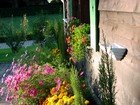

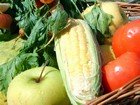
New! Comments
Do you have something of value to add? Leave me a comment in the box below.